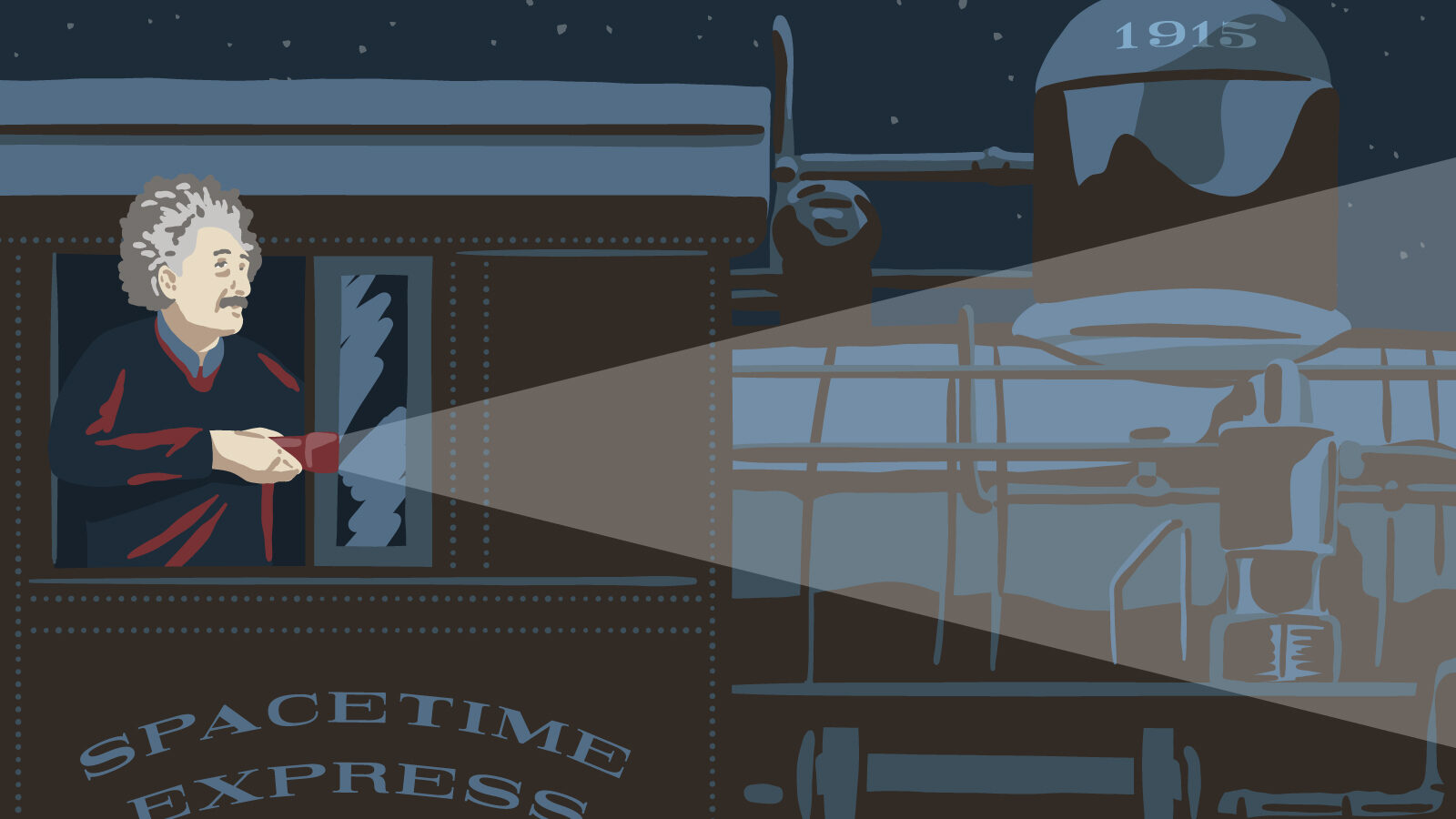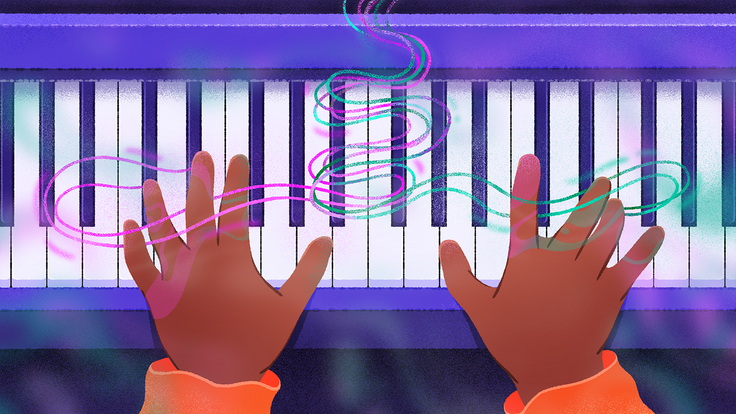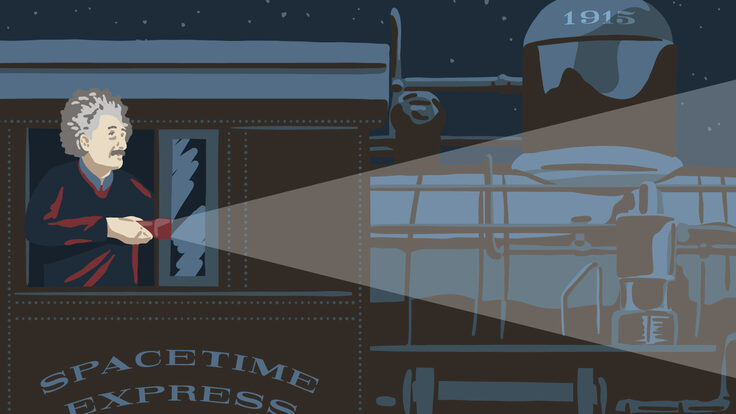At the start of the 20th century, physicists had a problem: The speed of light was always the speed of light.
If you threw a baseball out of a train going 20 mph, it would travel the speed at which you threw it plus 20 mph, just as Isaac Newton’s laws predicted. However, if you aimed a flashlight out of a train going 20 mph, the light would travel the speed of light—no more, no less—no matter your perspective. And according to Newton’s picture of the universe, that didn’t make any sense.
“We didn't have a theory that would explain why light was special,” says Lia Medeiros, a NASA Einstein fellow at Princeton University.
The key turned out to be something Albert Einstein would soon propose: the idea of spacetime.
“Spacetime is a necessary consequence of the fact that all observers measure the same value for the speed of light.”
The concept was revolutionary. “For common-day experience, as well as most experiments, space and time being separate is totally fine,” says Daniel Holz, a professor of physics and astrophysics at the University of Chicago. “But if you want to make a general statement about how the universe works, then you really need to view them as one object.”
A matter of perspective
In 1905, building on existing experimental and theoretical work, Einstein published the theory of special relativity. Among other things, the theory combined space and time into a single entity that he called spacetime.
“Spacetime is a necessary consequence of the fact that all observers measure the same value for the speed of light,” says Scott Hughes, a professor of physics at the Massachusetts Institute of Technology. “Einstein took the question ‘What if the speed of light is just the same to everyone?’ seriously. And spacetime grew out of that thought experiment.”
It all starts with the concept of different frames of reference. How a person experiences the world depends on their individual frame of reference. Two people standing together on a moving train will perceive one another as stationary. But an observer standing outside the train will perceive both of those people as in motion, chugging along at the speed of the train. Zoom out even farther, and another observer floating in space will perceive the person standing outside the train as in motion as well, spinning along with the Earth while in orbit around the sun, which in turn is flying through the galaxy.
What Einstein realized is that something similar happens with time: Different people will experience the passage of time differently, depending on their frame of reference. The key to understanding how this works is the universal speed of light.
Imagine a single quantum of light, a photon, bouncing up and down between two mirrors that are facing each other. Traveling at the speed of light, the photon should bounce at regular intervals, like a steadily ticking clock.
A person standing on a moving train with this photon clock will see the photon moving up and down in a line. To a person standing outside the moving train, on the platform, however, the photon will seem to move in a different way. Not only will the photon bounce up and down, it will also move forward with the train.
From one frame of reference—on the train—the photon follows the shortest possible path, a straight line. From another—on the platform—it follows a stretched-out zig-zag path instead.
The puzzle Einstein faced becomes apparent if you imagine two photon clocks, one sitting stationary on the platform, and the other whizzing by in the train.
If the speed of light is constant regardless of the frame of reference, then to the person on the train, the photon clock next to them will tick more quickly, while to the person on the platform, that same clock on the train will tick more slowly. This effect is called time dilation. A similar thought experiment, with the photon clock tipped on its side, shows that objects are more compact along the direction of the train's motion, an effect called length contraction.
This works out mathematically. It’s only when you combine the different measurements from the different frames of reference of space and time that all the observers will agree on the result, suggesting that space and time are inextricably linked.
“If you allow both space and time to change in a connected way, then everyone agrees that light moves at the speed of light,” Holz says. “Once you combine them, everything kind of follows naturally. The equations are very beautiful and elegant.”
Throwing spacetime for a curve
Spacetime is four-dimensional. We can move through the three dimensions of space at will, passing up and down, side to side, or forward and backward. But we are also always moving through a fourth dimension: time. “The only difference is that we as humans cannot decide to move forwards and backwards in time,” Medeiros says.
Because we don't have control over it, it’s hard for our human brains to conceptualize the fourth dimension of spacetime. “One way to think about spacetime is it’s really just space and time,” Holz says. “It’s what you’re familiar with. The only difference is that your space and time are not absolute; someone else may measure a different space and a different time. The physical object that is absolute is the combination: spacetime.”
A decade after Einstein published the theory of special relativity, he published a new work that made spacetime a bit easier to conceptualize.
The 1905 theory of special relativity wasn’t complete: It couldn’t account for gravity. This was fine for experiments on Earth, where gravity is weak, but the theory failed to describe situations in which gravity played a significant role.
In 1915, Einstein published the theory of general relativity. Unlike the flat spacetime described by special relativity, the spacetime described by general relativity could be curved. Einstein explained that the dynamical curvatures of spacetime were caused by massive objects, such as the sun.
Imagine spacetime as a trampoline. Massive objects warp spacetime, similar to the way a bowling ball sitting on a trampoline causes it to sag.
An object traveling through curved spacetime will follow a different path than an object traveling through flat spacetime. In some cases, curves around a massive object will transform the path of another object into an orbit, like the elliptical path the Earth follows around and around the sun.
“In some sense, the universe itself is spacetime,” Holz says. “You can't even start to think about it unless you are thinking of it in terms of this combined spacetime. It's like this crucial stage on which everything we understand plays out.”
Spacetime is not a new idea, but it’s still important in scientific study today. “In the last few years, spacetime has been front and center in many exciting discoveries,” Holz says.
Einstein’s theory of general relativity predicted the existence of black holes, which Medeiros studies, and gravitational waves, which Holz and Hughes study.
Medeiros works on the Event Horizon Telescope, which in 2019 published the first ever image of a black hole. A black hole is a curvature of spacetime with gravity so strong nothing can escape it, not even light. And that’s just what scientists found when they combined data from multiple observatories into a single picture. Medeiros says she is amazed “that somebody wrote down a series of equations, and 100 years later, that set of equations predicted the existence of this object and perfectly described what it would look like.”
Both Holz and Hughes study events measured by the Laser Interferometer Gravitational-Wave Observatory, which announced the discovery of gravitational waves in 2016. Gravitational waves are ripples in spacetime caused by the acceleration of massive and dense objects like neutron stars and black holes.
“The idea that time and space are best described as spacetime, and that spacetime itself is a dynamical thing that tells us about gravity, has really held up over the past eight years of data-taking,” Hughes says.
That’s something else multiple observers can agree on.













